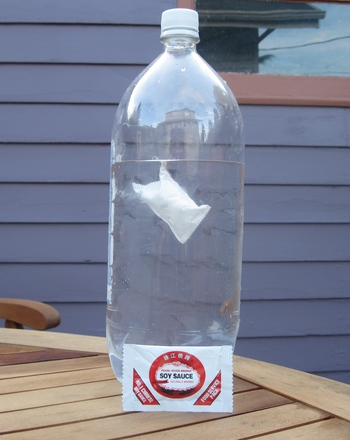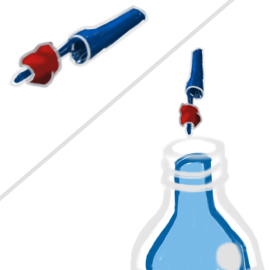 May 2018:
May 2018:
Materials:
• Plastic drinking bottle (1 or 2 L) with lid
• Water
• Ketchup or soy sauce packet or pen cap with modelling (or Sculpey) clay
Experiment:
Fill with water nearly to the top of the bottle.
Add the ketchup packet (or if using the pen cap, add about a pea-size piece of clay to the arm of the cap and put it in clay-side down – there should not be so much clay on it that the cap sinks in water – might want to see if it floats first in a glass of water – you want it to barely float).
Put the cap on the bottle tightly and squeeze the bottle.
You should see the packet (or cap) sink to the bottom. As you release the bottle the packet or cap should rise again. You can repeat this over and over.
 What’s happening?
What’s happening?
Rene Descartes (1596 – 1650) is thought to have invented this toy. Descartes is considered the father of Cartesian or analytic geometry used in the discovery of calculus and his name is the basis of the Cartesian coordinate system. The object floats on water because there is trapped air inside the packet or pen cap making the entire unit less dense than water. However, as you squeeze the bottle you are compressing that air causing it to take up less space. If an object has a mass and takes up a certain amount of space and then you make it take up less space, you will increase its density. In this case you change its density so much that it becomes “heavier” than the water and it sinks. When you stop squeezing the bottle, the air in the object expands again and the object becomes less dense and again floats to the top.
References:
https://sciencebob.com/make-a-cartesian-diver/
https://www.education.com/activity/article/soy-sauce-science/
To view all past “ChemShorts for Kids”, go to:
http://chicagoacs.org/ChemShorts
- Paul Brandt

 May 2018:
May 2018:  What’s happening?
What’s happening?